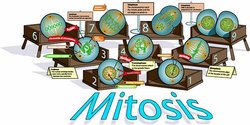Cell division
|
|
Cell division is the process of a biological cell (called a mother cell) dividing into two daughter cells. This leads to growth in multicellular organisms (the growth of tissue) and to procreation (vegetative reproduction) in unicellular organisms.
Prokaryotic cells divide by binary fission. Eukaryotic cells usually undergo a process of nuclear division, called mitosis, followed by division of the cell, called cytokinesis. A diploid cell may also undergo meiosis to produce haploid cells, usually four. Haploid cells serve as gametes in multicellular organisms, fusing to form new diploid cells.
Multicellular organisms replace worn-out cells through cell division. However, in some animals, cell division eventually halts, and the cell is then referred to as senescent. Senescent cells deteriorate and die, causing the body to age. Cells stop dividing because the telomeres, protective bits of DNA on the end of a chromosome, become shorter with each division and eventually can no longer protect the chromosome. Cancer cells, on the other hand, are "immortal." An enzyme called telomerase allows them to continue dividing indefinitely.
See also
External link
- How Cells Divide: Mitosis vs. Meiosis (http://www.pbs.org/wgbh/nova/baby/divide.html)

